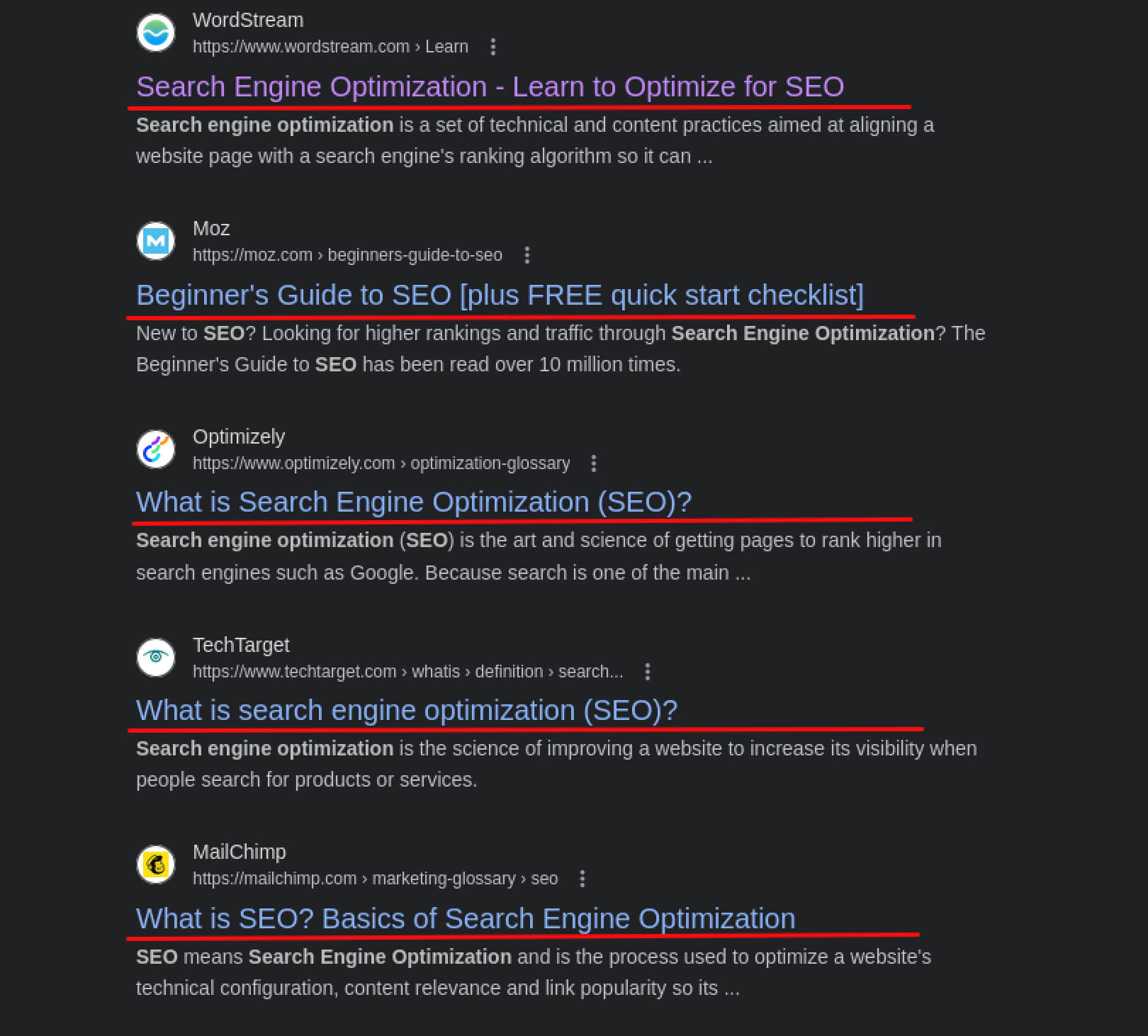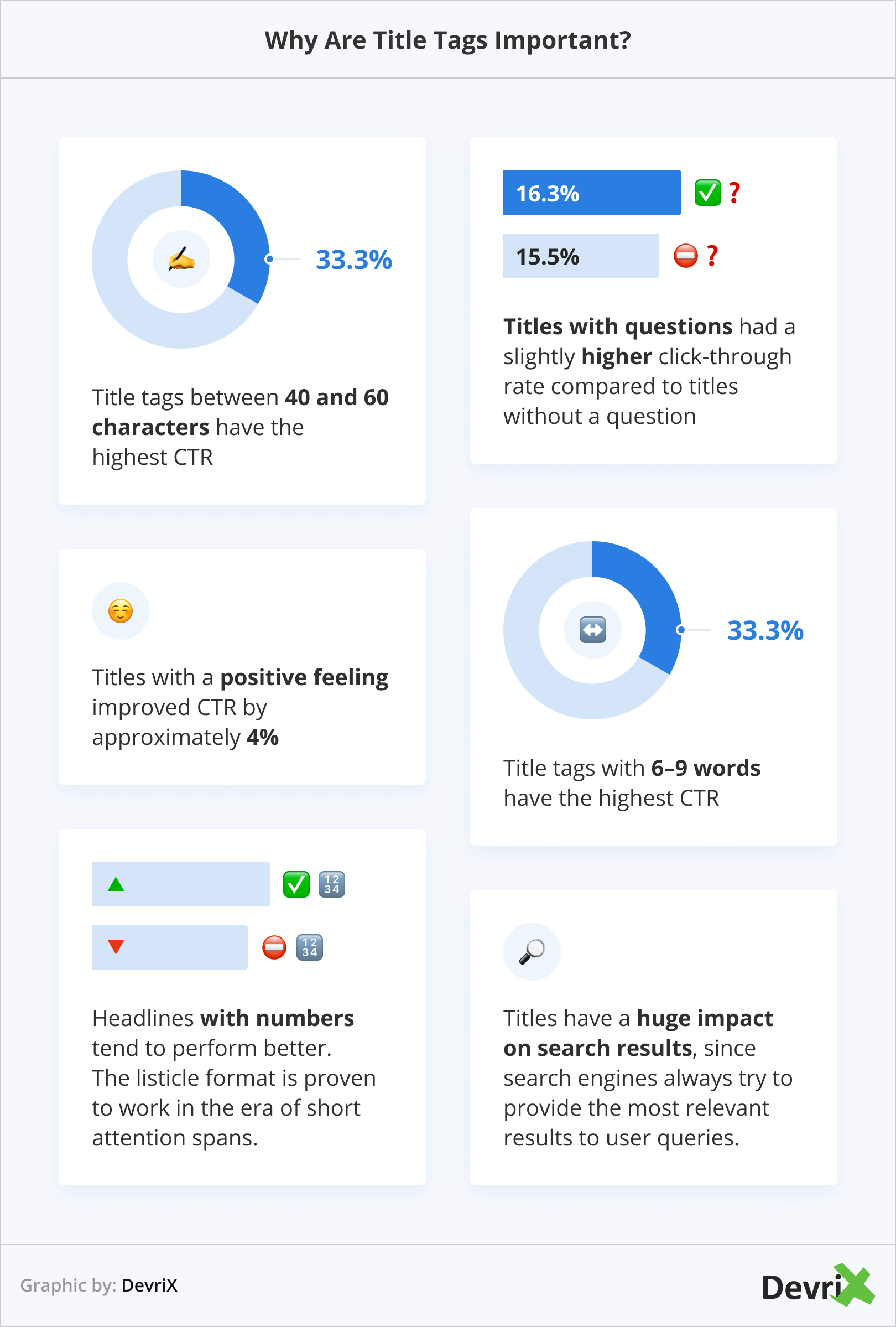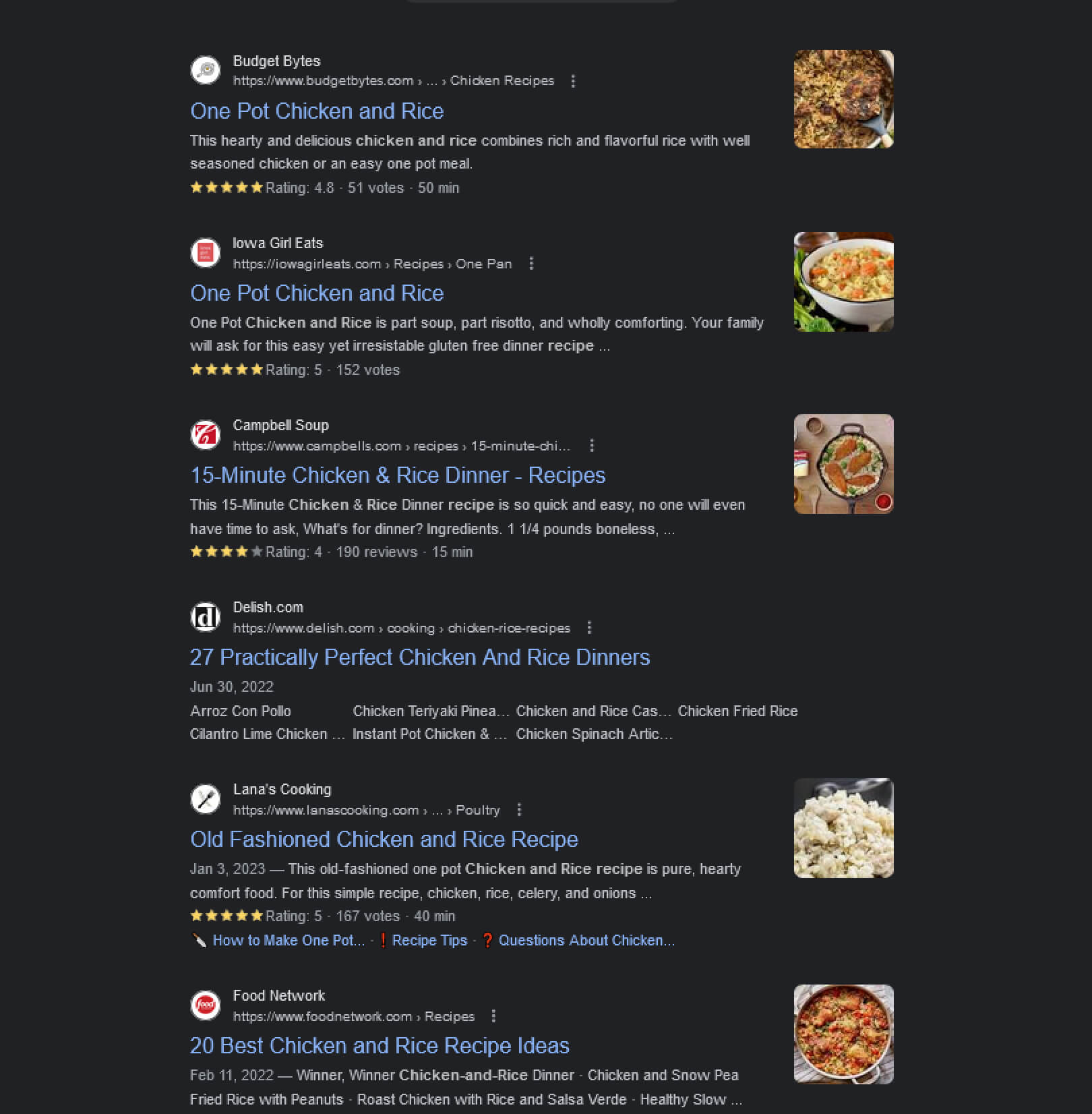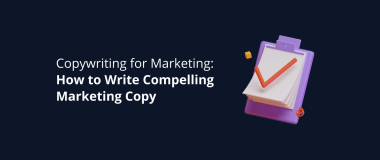You have written a great post – congratulations on that! Now what?
If you want your post to be seen by hundreds or even thousands of people, you must have followed the best SEO practices, right?
Surely you must have optimized your title tag? You see, the title tag is the first thing that users see when they are on a SERP, looking for a certain keyword.
You were not aware of that? Not to worry, we are here to help. Let us get started.
What Is a Title Tag?
Everyone who has used Google has seen a title tag, even if they were not aware that it is called that. Take a look at this example, and you will immediately understand what we are talking about:
In theory, a title tag is a piece of HTML code that displays the title of your page – article, blog post, home page, etc.
In practice, the title tag is an influential part of search engine results pages, as they are the first thing that grabs the attention of users.
Needless to say, it is of the utmost importance to craft a compelling title that will encourage users to click on your result, ahead of others.
Naturally, there are certain actions you can take, in order to maximize the effectiveness of titles, but more about that later. First, let us talk about…
Readers Also Enjoy: The Definitive Guide to Writing Powerful Content Headlines – DevriX
Post Title vs. SEO Title
Something that often confuses people is the distinction between the SEO title and the page (post) title. In a nutshell, the difference is:
- The post title is the headline you write to serve as a “name” for your post. It is meant for users that are already on your website.
- The SEO title is the headline you write to serve as an “endorsement” for your post. It is meant for users that are not on your website, but will see it on search engines.
Post title example:
SEO title example:
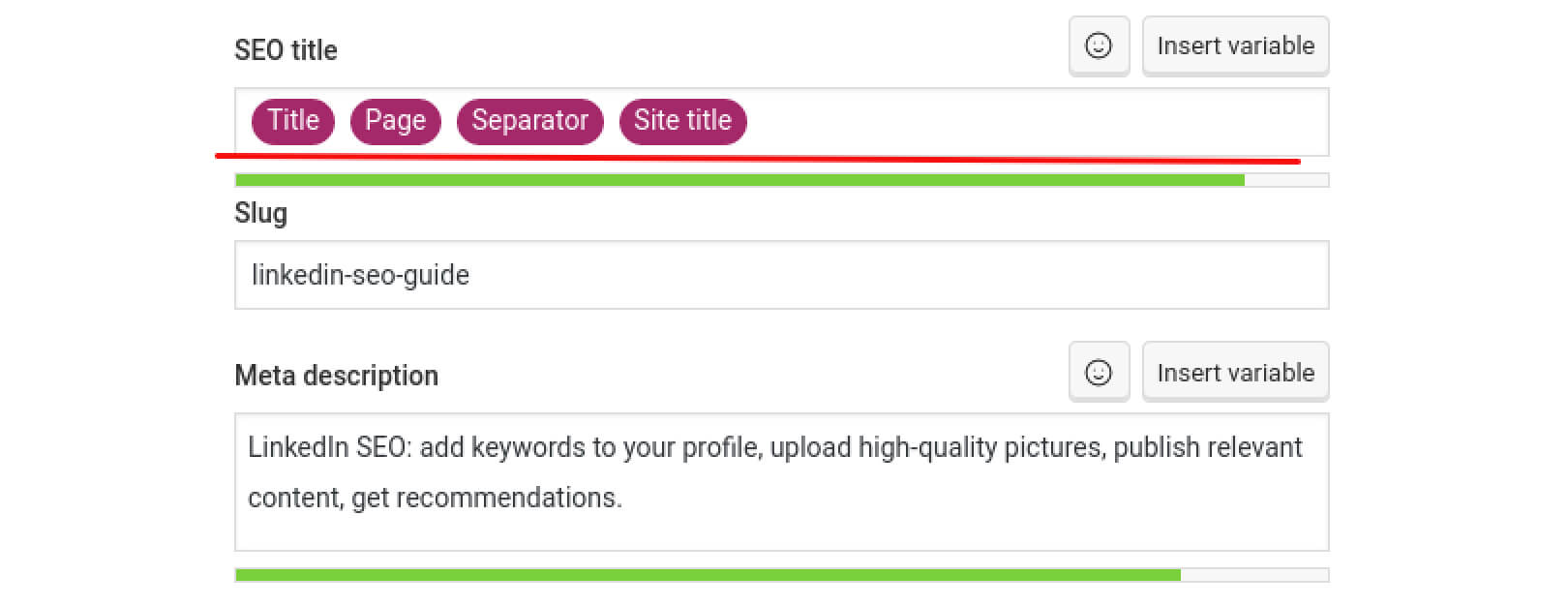
Of course, it is not mandatory to always write two different titles. Both your page and SEO title can be the same. For example, if you do not write a different SEO title, it will automatically take the same title you have set for the page, using the variables “title”, “page, etc.
However, you can experiment with the titles and write separate ones. If we take the example above, our page title is “LinkedIn SEO Guide: Get the Most Out of Your Profile”. We can decide to set the SEO title to be “LinkedIn SEO 2023: 7 Proven Tips”.
Will this action make any difference? Maybe. It is only throughout experimentation that we will know what the outcome will be. Just keep in mind that when you set different titles, Google may choose to display any of them, in place of what you want it to display.
How to Write Title Tags for SEO: Best Practices

- Keep Them Short
- Avoid Keyword Stuffing
- Write Unique Titles
- Add Your Brand
- Write for People
1. Keep Them Short
Generally, specialists recommend keeping your title between 50 and 60 characters. What is more, a study conducted by Backlinko found that title tags consisting of 40 to 60 characters have the highest click-through rate.
What is the worst that can happen if you ignore this advice, and decide to write long titles?
Well, you will not be penalized by Google for that. Still, title tags that contain too many characters will be cut short when displayed on SERPs.
However, this can leave readers wondering what you wanted to say, or in the worst case scenario completely ignore your article, in favor of another one with a shorter, fully visible, title.
Another thing. Sometimes Google can simply decide to rewrite your title. Why? Because it uses smart algorithms to determine if a page title is relevant to the content. So, keep that in mind when optimizing your titles.
Ultimately, it is always a good idea to double-check your SEO page title by using a tool like one of the following:
- What Are Title Tags? [Plus FREE Meta Title Preview Tool] – Moz
- Google Title & Description Preview Tool → Desktop/Mobile View
- Meta Length Checker – SERP Preview Tool 2023
2. Avoid Keyword Stuffing
You might be tempted to stuff your title with keywords, because keywords will rank you higher, right?
Well, that is not necessarily true. Sure, it’s nice to include your main keyword in your title, however you should not overdo it. For instance, let’s say you are writing an article about the best gaming mouse.
A title like “Best Gaming Mouse 2023: Tested & Reviewed” is totally sufficient. On the other hand, a title like “Best Gaming Mouse, Best Razor Gaming Mouse, Best Mouse for Gaming”, sounds unnatural, wouldn’t you agree?
The times of mindless keyword stuffing are long gone in the world of SEO. Nowadays, search engines, and Google, in particular, are focusing more and more on the user experience side. So, just keep it natural, you are trying to connect with humans, not just robots.
Readers Also Enjoy: Get Discovered with Search: Keyword Density Vs. LSI in SEO – DevriX
3. Write Unique Titles
Despite the world being in an AI craze recently, uniqueness is essential for all marketing efforts. The same goes for writing titles. Generic page names like “Home” or “New Page” will bring no value to your business, quite the opposite, they might keep people away from your pages.
Need any more convincing? Unique titles help search engines understand the uniqueness of your content, not to mention they drive higher click-through rates.
Sure, it can be hard to craft individual titles for hundreds and thousands of pages, which is the case for eCommerce websites. Still, you can follow a certain title format of including the name of the product, its category, and the name of your brand. For example, Jordan | Men’s Shoes | OurShoesWebsite
Additionally, you can boost your titles by using the so-called power words. Here are some examples of such words:
- Best
- Easy
- Top
- Simple
- Ultimate
- Fast
- Step-by-step
- Detailed
Again, do not overuse such words, as they will lose their effectiveness. Still, you can try to incorporate them into your titles, and experiment with them, in order to find out what works best for your audience, and your business.
Readers Also Enjoy: 13 Crushing eCommerce Website SEO Problems to Avoid [2022] – DevriX
4. Add Your Brand
It is always beneficial to include your brand at the end of your page title. If you are a well-known brand, adding your name can lead to higher click-through rates, traffic, and sales, respectively.
In case you are a smaller business, adding your brand can also help to increase your visibility, and simply help to get your name out there.
Readers Also Enjoy: Branded Keywords Vs. Non-Branded Keywords SEO: What You Need to Know – DevriX
5. Write for People
While it is important to think about search engine optimization, it is equally important to never forget who you are writing for: real people.
It is essential to consider the entire user experience: how would you attract new visitors through SERP results? Since the first impression does matter, think about how someone’s first interaction with your brand might feel.
If you are helpful, and give them enough information, then they will likely leave your site with a positive impression, which will stick with them the next time they notice your brand somewhere online.
On the other hand, a bad first impression can make visitors want to stay away from your business at all costs.
Readers Also Enjoy: How to Create Original Content And Win Readers? – DevriX
Why Are Title Tags Important?
They say you should never judge a book by its cover, yet people still do. Especially if it’s not a book, but an online article. The truth is that title tags are a crucial part of on-page SEO.
Here are some of the main reasons why they are so important:
- They encourage clicks. Your titles convey the overall message of your brand, and being a main feature in search engines results, they can often be the main factor that decides whether a user will click on your page, or not.
- They can be a ranking factor. Search engines use your titles as a ranking factor, so a well-optimized title can improve your ranking, which can enhance the visibility of your website, and attract more visitors.
- Attention grabbers. One of the goals of titles is to grab the attention of users. Using strong, compelling titles, optimized with relevant keywords, can help you bring more traffic to your website.
Readers Also Enjoy: How to Write a Product Review That Sells? – DevriX
Examples of Great SEO Page Titles
Let us take a look at a few examples of page titles, and analyze the good, and the bad. Cooking-related keywords are notoriously hard to rank for, because of the huge competition out there.
Let’s take one such example: “chicken and rice recipe”, with a global search volume of over 60 thousand (according to Semrush).
What can we take away from looking at the SERP?
The first two results use the same page titles, although the articles are quite different. Still, the titles are short, concise, and provide an easy recipe.
Next up, we have a time-specific result – 15-minute recipe, which again, lets users instantly know what to expect – a quick and easy recipe.
After that, there is an article about 27 different chicken and rice recipes. Once more, it provides people with immediate and straightforward information about the content of the article. You get the idea.
Moving on to the next example.
Here, we can take a look at the key phrase “best shoes for standing all day”, which has a global search volume of over 32 thousand (according to Semrush).
At the top, it is Sports Illustrated with their post, titled “The 11 Best Shoes for Standing All Day in 2023”.
What makes this a great title? First, it’s time-specific (2023), which tells users that this is a new, or updated material, which is up-to-date with the latest trends, and advancements.
Second, it’s a listicle with the 11 best shoes… This indicates that users can look and decide which is best for them.
Next, it is Forbes. They have decided to use a more emotional approach by using the phrase “Walk in Comfort”. If a user clicks on their article, they will find out that it is also a list with various shoes, however it is not indicated in the title.
The next result (Solereview) only used the target keyword as a title. It’s the same case – their page contains detailed information about various types of shoes, and when they are best for standing.
After that, you can see how the fourth result’s title is cut, because it is too long. Not that it makes it incomplete or confusing, but it is still better to set your titles, so they are visible all the way through.
Now, judging by the titles solely, all the three top results could easily take the first place. However, as mentioned before, Sports Illustrated have that privilege, due to their small, yet effective tweaks – the current year, and the number (11).
Readers Also Enjoy: What Are the Keys to Content Optimization in 2023 – DevriX
Wrap Up
Okay, folks, so what have we learned about titles today?
What is a title tag? It is metadata information displayed on search engine results pages that can greatly affect your click-through rate, website traffic, and overall user perception of your brand.
Follow the best SEO practices for page titles – make them short, unique, avoid keyword stuffing, and always keep in mind that you are writing for human beings.
Alright, now here’s a little challenge for you – tell us what you think about the title of this article? Does it fit the bill?
Leave a comment below, and let us know what you think and if you’d change the title of this article, and to what?
![What Is a Title Tag and How to Write One_ [Best SEO Practices]](https://devrix.com/wp-content/uploads/2023/05/What-Is-a-Title-Tag-and-How-to-Write-One_-Best-SEO-Practices-810x340.png)
